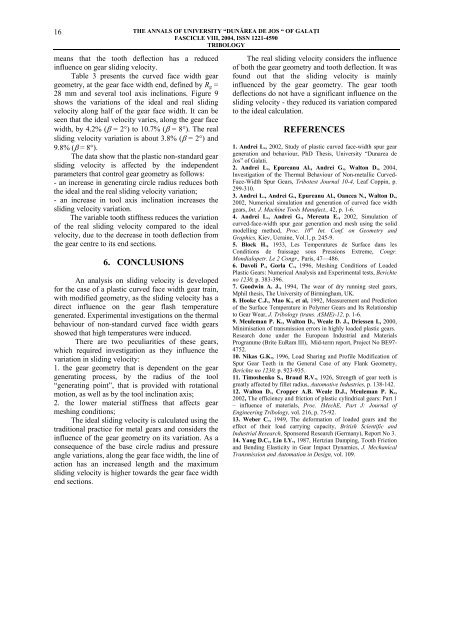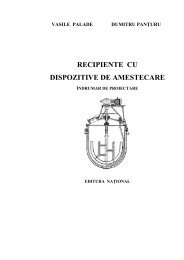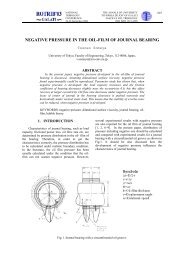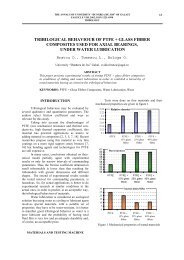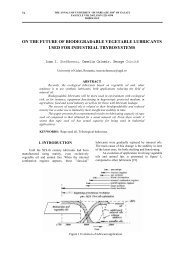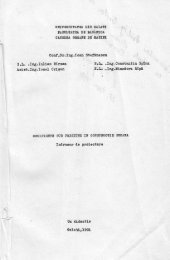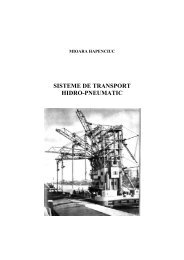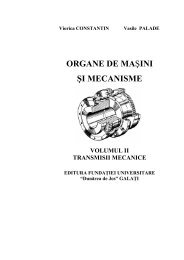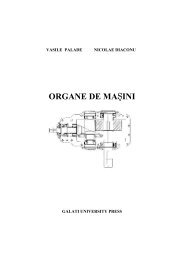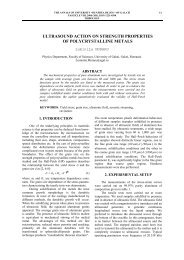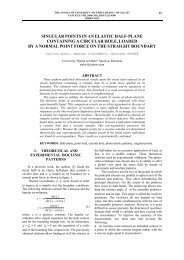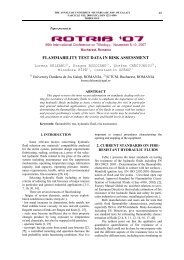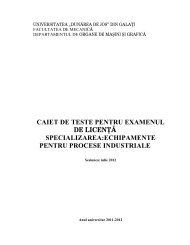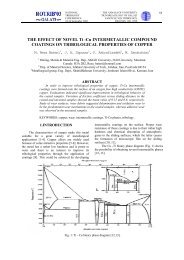INFLUENCE OF A NON-STANDARD GEOMETRY ... - Dunarea de Jos
INFLUENCE OF A NON-STANDARD GEOMETRY ... - Dunarea de Jos
INFLUENCE OF A NON-STANDARD GEOMETRY ... - Dunarea de Jos
You also want an ePaper? Increase the reach of your titles
YUMPU automatically turns print PDFs into web optimized ePapers that Google loves.
16<br />
THE ANNALS <strong>OF</strong> UNIVERSITY “DUNĂREA DE JOS “ <strong>OF</strong> GALAŢI<br />
FASCICLE VIII, 2004, ISSN 1221-4590<br />
TRIBOLOGY<br />
means that the tooth <strong>de</strong>flection has a reduced<br />
influence on gear sliding velocity.<br />
Table 3 presents the curved face width gear<br />
geometry, at the gear face width end, <strong>de</strong>fined by R g =<br />
28 mm and several tool axis inclinations. Figure 9<br />
shows the variations of the i<strong>de</strong>al and real sliding<br />
velocity along half of the gear face width. It can be<br />
seen that the i<strong>de</strong>al velocity varies, along the gear face<br />
width, by 4.2% (β = 2°) to 10.7% (β = 8°). The real<br />
sliding velocity variation is about 3.8% (β = 2°) and<br />
9.8% (β = 8°).<br />
The data show that the plastic non-standard gear<br />
sliding velocity is affected by the in<strong>de</strong>pen<strong>de</strong>nt<br />
parameters that control gear geometry as follows:<br />
- an increase in generating circle radius reduces both<br />
the i<strong>de</strong>al and the real sliding velocity variation;<br />
- an increase in tool axis inclination increases the<br />
sliding velocity variation.<br />
The variable tooth stiffness reduces the variation<br />
of the real sliding velocity compared to the i<strong>de</strong>al<br />
velocity, due to the <strong>de</strong>crease in tooth <strong>de</strong>flection from<br />
the gear centre to its end sections.<br />
6. CONCLUSIONS<br />
An analysis on sliding velocity is <strong>de</strong>veloped<br />
for the case of a plastic curved face width gear train,<br />
with modified geometry, as the sliding velocity has a<br />
direct influence on the gear flash temperature<br />
generated. Experimental investigations on the thermal<br />
behaviour of non-standard curved face width gears<br />
showed that high temperatures were induced.<br />
There are two peculiarities of these gears,<br />
which required investigation as they influence the<br />
variation in sliding velocity:<br />
1. the gear geometry that is <strong>de</strong>pen<strong>de</strong>nt on the gear<br />
generating process, by the radius of the tool<br />
“generating point”, that is provi<strong>de</strong>d with rotational<br />
motion, as well as by the tool inclination axis;<br />
2. the lower material stiffness that affects gear<br />
meshing conditions;<br />
The i<strong>de</strong>al sliding velocity is calculated using the<br />
traditional practice for metal gears and consi<strong>de</strong>rs the<br />
influence of the gear geometry on its variation. As a<br />
consequence of the base circle radius and pressure<br />
angle variations, along the gear face width, the line of<br />
action has an increased length and the maximum<br />
sliding velocity is higher towards the gear face width<br />
end sections.<br />
The real sliding velocity consi<strong>de</strong>rs the influence<br />
of both the gear geometry and tooth <strong>de</strong>flection. It was<br />
found out that the sliding velocity is mainly<br />
influenced by the gear geometry. The gear tooth<br />
<strong>de</strong>flections do not have a significant influence on the<br />
sliding velocity - they reduced its variation compared<br />
to the i<strong>de</strong>al calculation.<br />
REFERENCES<br />
1. Andrei L., 2002, Study of plastic curved face-width spur gear<br />
generation and behaviour, PhD Thesis, University “<strong>Dunarea</strong> <strong>de</strong><br />
<strong>Jos</strong>” of Galati.<br />
2. Andrei L., Epureanu Al., Andrei G., Walton D., 2004,<br />
Investigation of the Thermal Behaviour of Non-metallic Curved-<br />
Face-Width Spur Gears, Tribotest Journal 10-4, Leaf Coppin, p.<br />
299-310.<br />
3. Andrei L., Andrei G., Epureanu Al., Oancea N., Walton D.,<br />
2002, Numerical simulation and generation of curved face width<br />
gears, Int. J. Machine Tools Manufact., 42, p. 1-6.<br />
4. Andrei L., Andrei G., Mereuta E., 2002, Simulation of<br />
curved-face-width spur gear generation and mesh using the solid<br />
mo<strong>de</strong>lling method, Proc. 10 th Int. Conf. on Geometry and<br />
Graphics, Kiev, Ucraine, Vol.1, p. 245-9.<br />
5. Block H., 1933, Les Temperatures <strong>de</strong> Surface dans les<br />
Conditions <strong>de</strong> fraissage sous Pressions Extreme, Congr.<br />
Mondialopetr. Le 2 Congr., Paris, 47—486.<br />
6. Davoli P., Gorla C., 1996, Meshing Conditions of Loa<strong>de</strong>d<br />
Plastic Gears: Numerical Analysis and Experimental tests, Berichte<br />
no 1230, p. 383-396.<br />
7. Goodwin A. J., 1994, The wear of dry running steel gears,<br />
Mphil thesis, The University of Birmingham, UK.<br />
8. Hooke C.J., Mao K., et al, 1992, Measurement and Prediction<br />
of the Surface Temperature in Polymer Gears and Its Relationship<br />
to Gear Wear, J. Tribology (trans. ASME)-12, p. 1-6.<br />
9. Meuleman P. K., Walton D., Weale D. J., Driessen I., 2000,<br />
Minimisation of transmission errors in highly loa<strong>de</strong>d plastic gears.<br />
Research done un<strong>de</strong>r the European Industrial and Materials<br />
Programme (Brite EuRam III), Mid-term report, Project No BE97-<br />
4752.<br />
10. Nikas G.K., 1996, Load Sharing and Profile Modification of<br />
Spur Gear Teeth in the General Case of any Flank Geometry,<br />
Berichte no 1230, p. 923-935.<br />
11. Timoshenko S., Braud R.V., 1926, Strength of gear teeth is<br />
greatly affected by fillet radius, Automotive Industries, p. 138-142.<br />
12. Walton D., Cropper A.B. Weale D.J., Meuleman P. K.,<br />
2002, The efficiency and friction of plastic cylindrical gears: Part 1<br />
– influence of materials, Proc. IMechE, Part J: Journal of<br />
Engineering Tribology, vol. 216, p. 75-92.<br />
13. Weber C., 1949, The <strong>de</strong>formation of loa<strong>de</strong>d gears and the<br />
effect of their load carrying capacity, British Scientific and<br />
Industrial Research, Sponsored Research (Germany), Report No 3.<br />
14. Yang D.C., Lin I.Y., 1987, Hertzian Damping, Tooth Friction<br />
and Bending Elasticity in Gear Impact Dynamics, J. Mechanical<br />
Transmission and Automation in Design, vol. 109.


